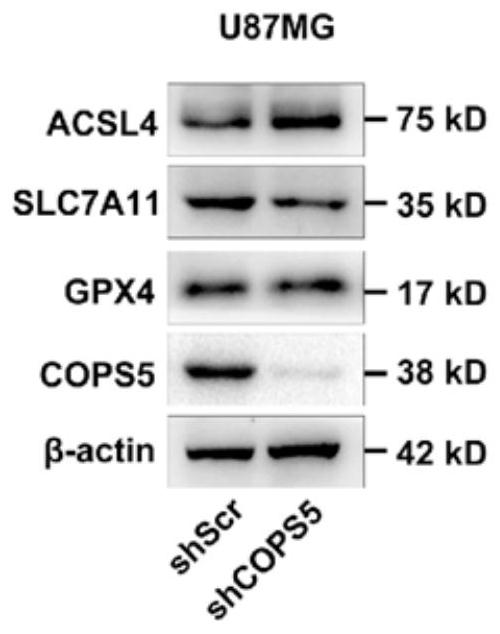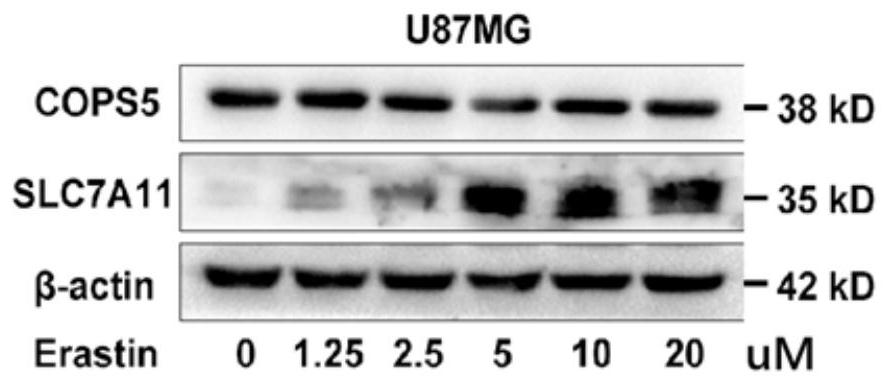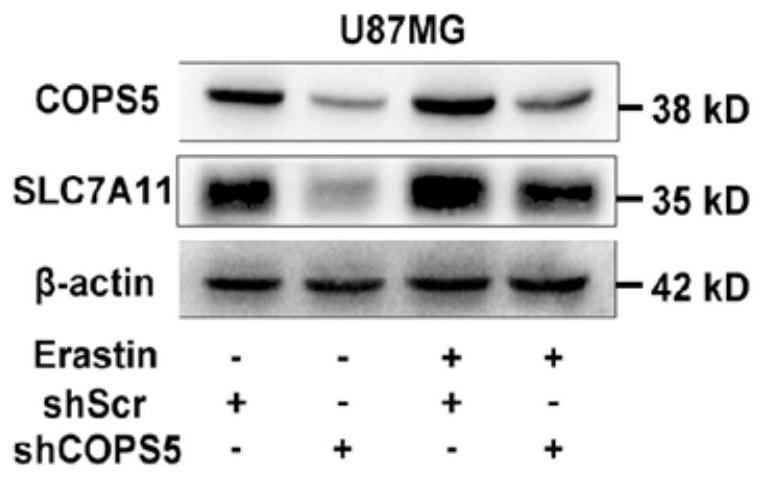Method for improving curative effect of temozolomide in glioblastoma
A technology for glioblastoma and temozolomide, which is applied in the field of improving the efficacy of glioblastoma temozolomide, and can solve problems such as complex mechanisms
- Summary
- Abstract
- Description
- Claims
- Application Information
AI Technical Summary
Problems solved by technology
Method used
Image
Examples
Embodiment 1
[0033] An interference plasmid for knocking down the expression of COPS5 protein in glioblastoma cell lines, the gene sequence is CCAGACTATTCCACTTAATTT. COPS5: Photogenerating factor 9 complex subunit 5 protein.
[0034] In the study, it was found that the photogenetic factor 9 complex subunit 5 (COPS5) protein was expressed in glioblastoma, and was involved in regulating the ferroptosis process of glioblastoma cells, thereby affecting the drug resistance of temozolomide in treatment.
[0035] The COPS5 expression interference plasmid is specifically an shRNA (short hairpin RNA) plasmid, which is to clone two short inverted repeat sequences specifically targeting the COPS5 gene into the expression vector plasmid, and cause the degradation of the mRNA transcribed by COPS5 after transfection into the cell, and then Interfering with the expression of the COPS5 gene reduces the level of COPS5 protein in cells. This interference plasmid is specially designed for the COPS5 gene, an...
Embodiment 2
[0044] The use of the interfering plasmid used in Example 1 for knocking down the expression of COPS5 protein in glioblastoma cell lines as a drug to solve the drug resistance problem of temozolomide in treatment.
[0045] Knockdown of COPS5 expression combined with temozolomide treatment, compared with knockdown of COPS5 expression alone and temozolomide treatment alone, combined treatment has a better effect on inhibiting the growth of glioblastoma. Such as Figure 8 As shown, compared with the control group, compared with the group using the interference plasmid shCOPS5 alone and the group using temozolomide alone, the combined application of the COPS5 interference plasmid COPS5 and temozolomide had smaller subcutaneous tumor volume in nude mice.
[0046] The interfering plasmid used for knocking down the expression of COPS5 protein in glioblastoma cell lines of the present invention can achieve a more obvious tumor inhibitory growth effect by promoting glioblastoma cell fe...
Embodiment 3
[0048] Provided is a use of a combination drug composed of an interference plasmid for knocking down COPS5 protein expression combined with temozolomide as a chemotherapeutic drug for glioblastoma.
[0049] Knockdown of COPS5 combined with temozolomide can achieve a more significant tumor-inhibitory growth effect by promoting ferroptosis in glioblastoma cells and reducing temozolomide resistance. It can be used as a new drug to improve the efficacy of temozolomide in glioblastoma.
[0050] Such as Figure 9 As shown, in the subcutaneous tumor formation experiment of nude mice, compared with the control group, the volume and weight of subcutaneous tumors in nude mice were significantly reduced after treatment with the COPS5 interference plasmid shCOPS5 and temozolomide, and this trend was even more pronounced under the action of the ferroptosis agonist Erastin. Obviously, it disappeared under the action of ferroptosis inhibitor Erastin-Fer-1.
[0051] It can be seen that the ...
PUM
 Login to View More
Login to View More Abstract
Description
Claims
Application Information
 Login to View More
Login to View More - R&D
- Intellectual Property
- Life Sciences
- Materials
- Tech Scout
- Unparalleled Data Quality
- Higher Quality Content
- 60% Fewer Hallucinations
Browse by: Latest US Patents, China's latest patents, Technical Efficacy Thesaurus, Application Domain, Technology Topic, Popular Technical Reports.
© 2025 PatSnap. All rights reserved.Legal|Privacy policy|Modern Slavery Act Transparency Statement|Sitemap|About US| Contact US: help@patsnap.com



